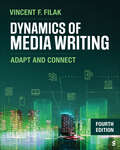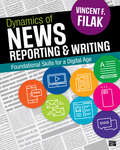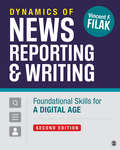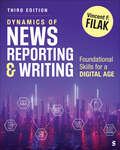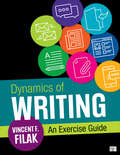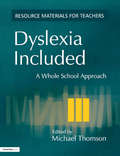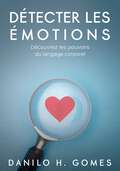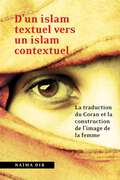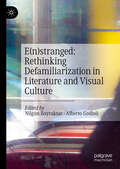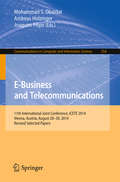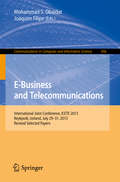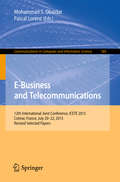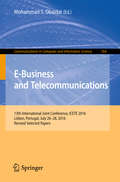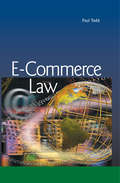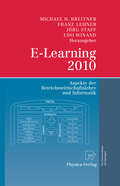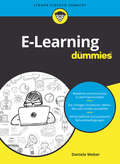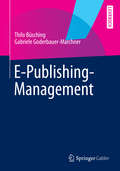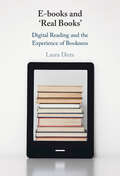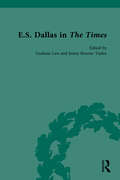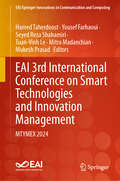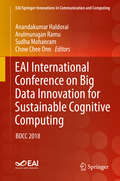- Table View
- List View
Dynamics of Media Writing: Adapt and Connect
by Vincent F. FilakDynamics of Media Writing gives students transferable skills that can be applied across all media platforms—from traditional mass media formats like news, public relations, and advertising to emerging digital media platforms. Whether issuing a press release or tweeting about a new app, today’s media writers need to adapt their message for each specific media format in order to successfully connect with their audience. Throughout this text, author Vincent F. Filak introduces fundamental writing skills that apply to all media, while also highlighting which writing tools and techniques are most effective for specific media formats and why. User-friendly and loaded with practical examples and tips from professionals across mass media, this is the perfect guide for any student wanting to launch a professional media writing career. The newly revised Fourth Edition features a new chapter centered around artificial intelligence (AI), in addition to highlighting recent developments in writing for websites and blogs, new interviews with working journalists on recent changes in the industry, and updated examples to show success digital media writing strategies.
Dynamics of News Reporting and Writing: Foundational Skills for a Digital Age
by Vincent F. FilakJournalists in today’s media environment require a skill set that can be adapted to a variety of media. Dynamics of News Reporting and Writing: Foundational Skills for a Digital Age teaches students the foundational skills they need to successfully report and write the news in an evolving digital landscape. Author Vince F. Filak offers guidance on the essential skills of the industry while weaving in the “how-to’s” of writing digital news. Recognizing that well-crafted stories are founded on sharp prose, this new text covers the foundational elements of newswriting, such as lead writing, structure, and storytelling while also teaching students how to think critically and determine what matters most to their readers. Key Features: An audience-centric approach encourages students to understand why and how news is relevant to the lives of their readers before they even start digging into their stories. “Write Now! Exercises” provide students with an opportunity to immediately practice the core set of skills they have just learned and apply these skills to various platforms. “Consider This” debates spark classroom discussions by encouraging students to take a closer look at a current issue or ideological dilemma and make a valid case for their position. “Thoughts from a Pro” offer students an up-close look at a specific aspect of reporting and writing from a professional who is plying their trade each day.
Dynamics of News Reporting and Writing: Foundational Skills for a Digital Age
by Vincent F. FilakJournalists in today’s media environment require a skill set that can be adapted to a variety of media. Dynamics of News Reporting and Writing: Foundational Skills for a Digital Age teaches students the foundational skills they need to successfully report and write the news in an evolving digital landscape. Author Vince F. Filak offers guidance on the essential skills of the industry while weaving in the “how-to’s” of writing digital news. Recognizing that well-crafted stories are founded on sharp prose, this new text covers the foundational elements of newswriting, such as lead writing, structure, and storytelling while also teaching students how to think critically and determine what matters most to their readers. Key Features: An audience-centric approach encourages students to understand why and how news is relevant to the lives of their readers before they even start digging into their stories. “Write Now! Exercises” provide students with an opportunity to immediately practice the core set of skills they have just learned and apply these skills to various platforms. “Consider This” debates spark classroom discussions by encouraging students to take a closer look at a current issue or ideological dilemma and make a valid case for their position. “Thoughts from a Pro” offer students an up-close look at a specific aspect of reporting and writing from a professional who is plying their trade each day.
Dynamics of News Reporting and Writing: Foundational Skills for a Digital Age
by Vincent F. FilakDynamics of News Reporting and Writing: Foundational Skills for a Digital Age shows students how to approach their stories and think on their feet in the evolving media landscape. Recognizing that well-crafted stories are founded on sharp prose, author Vincent F. Filak covers more foundational elements of a newswriting textbook, like lead writing, structure, and storytelling, while also teaching students how to think critically and determine what matters most to their readers. The Second Edition includes even more writing and grammar exercises, discussions of social media and digital media advancements, and additional career-related examples to help students succeed upon entering the field.
Dynamics of News Reporting and Writing: Foundational Skills for a Digital Age
by Vincent F. FilakDynamics of News Reporting and Writing: Foundational Skills for a Digital Age shows students how to approach their stories and think on their feet in the evolving media landscape. Recognizing that well-crafted stories are founded on sharp prose, author Vincent F. Filak covers more foundational elements of a newswriting textbook, like lead writing, structure, and storytelling, while also teaching students how to think critically and determine what matters most to their readers. The Second Edition includes even more writing and grammar exercises, discussions of social media and digital media advancements, and additional career-related examples to help students succeed upon entering the field.
Dynamics of News Reporting and Writing: Foundational Skills for a Digital Age
by Vincent F. FilakDynamics of News Reporting and Writing: Foundational Skills for a Digital Age shows students how to approach their stories and think on their feet in the evolving media landscape. Recognizing that well-crafted stories are founded on sharp prose, author Vincent F. Filak guides students through the essential elements of newswriting, such as lead writing, structure, and storytelling, in a chapter-by-chapter approach, while also teaching them how to think critically and focus on what matters most to their readers. The Third Edition features expanded writing and grammar exercises, discussions on social and digital media advancements, new coverage of artificial intelligence and generative AI, and additional career-related examples to help students succeed upon entering the field.
Dynamics of News Reporting and Writing: Foundational Skills for a Digital Age
by Vincent F. FilakDynamics of News Reporting and Writing: Foundational Skills for a Digital Age shows students how to approach their stories and think on their feet in the evolving media landscape. Recognizing that well-crafted stories are founded on sharp prose, author Vincent F. Filak guides students through the essential elements of newswriting, such as lead writing, structure, and storytelling, in a chapter-by-chapter approach, while also teaching them how to think critically and focus on what matters most to their readers. The Third Edition features expanded writing and grammar exercises, discussions on social and digital media advancements, new coverage of artificial intelligence and generative AI, and additional career-related examples to help students succeed upon entering the field.
Dynamics of Writing: An Exercise Guide
by Vincent F. FilakDynamics of Writing: An Exercise Guide gives students multiple opportunities to practice their writing skills in-class or as take-home assignments. Each chapter focuses on a different aspect of the newswriting process and offers short-answer, multiple-choice, and writing-prompt activities to help students master the concepts and skills presented in Vincent F. Filak’s comprehensive book. Additional exercises built around the unique demands of online newswriting will prepare students to meet the demands of a changing media landscape. Key Features: "Writing Exercises" enable students to recall & demonstrate their understanding of various elements found in each chapter in Dynamics of News Writing and Reporting. "Practice Writing" exercises empower students to apply their knowledge in a safe, in-class environment. "Live-Action Exercises" encourage students to expand their knowledge and experience through out-of-class reporting and writing opportunities. Bundle this workbook with Dynamics of News Writing and Reporting.
Dynamics of Writing: An Exercise Guide
by Vincent F. FilakDynamics of Writing: An Exercise Guide gives students multiple opportunities to practice their writing skills in-class or as take-home assignments. Each chapter focuses on a different aspect of the newswriting process and offers short-answer, multiple-choice, and writing-prompt activities to help students master the concepts and skills presented in Vincent F. Filak’s comprehensive book. Additional exercises built around the unique demands of online newswriting will prepare students to meet the demands of a changing media landscape. Key Features: "Writing Exercises" enable students to recall & demonstrate their understanding of various elements found in each chapter in Dynamics of News Writing and Reporting. "Practice Writing" exercises empower students to apply their knowledge in a safe, in-class environment. "Live-Action Exercises" encourage students to expand their knowledge and experience through out-of-class reporting and writing opportunities. Bundle this workbook with Dynamics of News Writing and Reporting.
Dyslexia Included: A Whole School Approach
by Michael ThomsonThis practical book provides teachers with techniques and suggestions to help dyslexic pupils. Written by a team of experienced practitioners who work in a specialist school, it offers clear guidance and tried and tested strategies to help those who need support in this area. The book addresses reading and spelling difficulties and also other aspects of pupils' learning difficulties, including: accessing the curriculum; dyspraxia and motor development problems; learning mathematics; the use of ICT; developing phonological coding; and understanding dyslexics' behaviour. Teachers and teaching assistants working in specialist and mainstream primary and secondary schools should find the book useful. It is also relevant to those doing specialist courses in dyslexia.
Détecter les émotions: Découvrez les pouvoirs du langage corporel
by Danilo H. GomesLe cerveau est sans aucun doute une machine incroyable et unique, mais il n'était pas programmé pour toujours agir de manière cachée. Même si vous pouvez mémoriser tous les détails de ce livre, soyez très prudent. Pas toujours ce qu'il semble, c'est. Une personne qui reste oisive tout en écoutant ses histoires peut être désintéressée, mais peut aussi être simplement froide. Le contexte dans lequel l'individu est inséré doit toujours être pris en compte. Avoir une bonne observation et interpréter facilement le langage corporel est une compétence dominée par peu et peut être une bonne arme utilisée pour le bien ou le mal.
D’un islam textuel vers un islam contextuel: La traduction du Coran et la construction de l’image de la femme (Regards sur la traduction)
by Naïma DibLa mise en tutelle de la musulmane est-elle cautionnée par le Coran? L'idée de l'infériorité de la femme est-elle réellement inscrite dans le Coran? Telles sont les questions auxquelles l'auteure tente de répondre dans le présent ouvrage. Elle se penche sur les diverses approches adoptées par des penseurs réformistes musulmans, dont elle expose les enjeux sociaux, politiques et culturels ainsi que les finalités. Elle procède à une analyse comparative du Coran et d'un certain nombre de traductions françaises et anglaises, à l'issue de laquelle elle fait émerger une conception de la femme et du monde différente de celle proposée par les traductions. Elle explore ensuite le discours social commun, discours auquel participe la traduction, et qui se révèle empreint d'une vision androcentrique dans laquelle l'infériorité de la femme découle d'une construction humaine, inspirée par un besoin de domination. Grâce aux analyses sémiotique et sociohistorique, l'auteur démontre que le Coran peut être lu autrement et ce qui en ressort est une conception plus égalitaire de l'homme et de la femme. Publié en français
E(n)stranged: Rethinking Defamiliarization in Literature and Visual Culture
by Nilgun Bayraktar Alberto GodioliVariously translated as “estrangement,” “enstrangement” or “defamiliarization,” Viktor Shklovsky’s concept of ostranenie is more relevant than ever. This collection offers new insights into the theories and practices of ostranenie across various languages and cultures, with a particular focus on the 20th and 21st centuries. Our current era is marked by a dramatic redefinition of the normal and the strange, the familiar and the weird. The rise of far-right populism has increasingly normalized xenophobic and nativist stances previously confined to the fringes of the political spectrum. Additionally, the climate crisis has led to the ongoing renegotiation of the concepts of normalcy and emergency amid widespread efforts to adapt to the “new (ab)normal.” Exploring defamiliarization provides a unique perspective to comprehend and question these processes and their profound cultural implications. Focusing on ostranenie also offers valuable insights into how aesthetic forms serve a political function. Defamiliarization can take on various forms, including retro-futuristic dystopias, stylized films, and darkly humorous cartoons and memes. It can be an effective tool for political activation that relies on formal innovation rather than superficial emotional engagement. This collection brings together the work of a group of scholars examining defamiliarization across different media. It explores questions such as: How can we differentiate between various forms of defamiliarization and analyze their effects on the reader/viewer? How is defamiliarization connected to the weird, the eerie, or the uncanny? As a result, the collection offers an updated theoretical framework for understanding the wide range of emergent artistic and literary practices of e(n)strangement in the current era and their significant political affordances. Chapter 6 is available open access under a Creative Commons Attribution 4.0 International License via link.springer.com
E-Business and Telecommunications
by Mohammad S. Obaidat Andreas Holzinger Joaquim FilipeThis book constitutes the refereed proceedings of the 11th International Joint Conference on E-Business and Telecommunications, ICETE 2014, held in Vienna, Austria, in August 2014. ICETE is a joint international conference integrating four major areas of knowledge that are divided into six corresponding conferences: International Conference on Data Communication Networking, DCNET; International Conference on E-Business, ICE-B; International Conference on Optical Communication Systems, OPTICS; International Conference on Security and Cryptography, SECRYPT; International Conference on Wireless Information Systems, WINSYS; and International Conference on Signal Processing and Multimedia, SIGMAP. The 27 full papers presented were carefully reviewed and selected from 328 submissions. The papers cover the following key areas of e-business and telecommunications: data communication networking; e-business; optical communication systems; security and cryptography; signal processing and multimedia applications; wireless information networks and systems.
E-Business and Telecommunications
by Mohammad S. Obaidat Joaquim FilipeThis book constitutes the refereed proceedings of the 9th International Joint Conference on E-Business and Telecommunications, ICETE 2012, held in Rome, Italy, in July 2012. ICETE is a joint international conference integrating four major areas of knowledge that are divided into six corresponding conferences: International Conference on Data Communication Networking, DCNET; International Conference on E-Business, ICE-B; International Conference on Optical Communication Systems, OPTICS; International Conference on Security and Cryptography, SECRYPT; International Conference on Wireless Information Systems, WINSYS; and International Conference on Signal Processing and Multimedia, SIGMAP. The 18 full papers presented were carefully reviewed and selected from 403 submissions. They cover a wide range of topics in the key areas of e-business and telecommunications.
E-Business and Telecommunications
by Mohammad S. Obaidat Pascal LorenzThis bookconstitutes the refereed proceedings of the 12th International Joint Conferenceon E-Business and Telecommunications, ICETE 2015, held in Colmar, France, inJuly 2015. ICETE is a joint international conference integrating four majorareas of knowledge that are divided into six corresponding conferences:International Conference on Data Communication Networking, DCNET; InternationalConference on E-Business, ICE-B; International Conference on OpticalCommunication Systems, OPTICS; International Conference on Security andCryptography, SECRYPT; International Conference on Wireless InformationSystems, WINSYS; and International Conference on Signal Processing andMultimedia, SIGMAP. The 23 fullpapers presented together with an invited paper in this volume were carefully reviewed and selected from 218 submissions. Thepapers cover the following key areas of e-business and telecommunications: datacommunication networking; e-business; optical communication systems; securityand cryptography; signal processing and multimedia applications; wirelessinformation networks and systems.
E-Business and Telecommunications
by Mohammad S. ObaidatThis book constitutes the best papers of the Third International Conference on E-business and Telecommunication Networks, ICETE 2006, held in SetAbal, Portugal, August 7-10, 2006. The 29 revised full papers presented were carefully reviewed and selected from 326 submissions. The papers are organized in four parts according to their conferences: ICE-B, SECRYPT, SIGMAP and WINSYS.
E-Commerce Law
by Paul ToddThis book includes detailed coverage of intellectual property, contract, encryption and liability issues, including allocation of domain names, use of metatags and other forms of search engine optimization, digital signatures and the position of ISPs and other intermediaries. There are case studies on electronic conveyancing and e-taxation. Though the book is written from a UK perspective, comparative material is included from other jurisdictions, including America and Singapore in particular.
E-Learning 2010
by Franz Lehner Jörg Staff Michael Breitner Udo WinandTechnologiebasiertes und mobiles Lernen und Lehren sind in der Informations- und Wissensgesellschaft von zentraler Bedeutung. Ziel des Sammelbandes ist es, einen Blick in die nahe Zukunft des E- und M-Learnings zu werfen: der lebenslangen Aus- und Weiterbildung vom Vorschul- bis ins Rentenalter unter Verwendung von Rechnern und Rechnernetzwerken. Bei der Entwicklung solcher Angebote kommt es vor allem darauf an, ganzheitliche, integrierte Ansätze zu finden, die die drei Säulen Technologie, Didaktik und Betriebswirtschaftslehre berücksichtigen.
E-Learning für Dummies (Für Dummies)
by Daniela WeberEgal, ob beim Unterrichten an der Uni, bei Weiterbildungen im Job oder bei der Arbeit von Trainern, ohne Lerninhalte im Internet ist dies kaum mehr vorstellbar. Erfahren Sie wie Sie Ihr Online-Angebot richtig erstellen. Daniela Weber erklärt Ihnen die Grundlagen des E-Learning und gibt Ihnen das richtige Handwerkszeug mit, um bewährte und innovative E-Learning-Konzepte erfolgreich und im Budget umzusetzen. Dabei erfahren Sie alles Wichtige von der Wahl der geeigneten Instrumente und Inhalte bis hin zur Implementierung Ihres E-Learning-Angebots. So gelingt Ihr Start in der Online-Lehre.
E-Publishing-Management
by Thilo Büsching Gabriele Goderbauer-MarchnerThilo Büsching und Gabriele Goderbauer-Marchner analysieren sowohl wissenschaftlich fundiert als auch praxisorientiert, wie E-Publishing-Produkte entwickelt, realisiert und vermarktet werden. Das Spektrum reicht von innovativen Geschäfts- und Erlösmodellen über klassische Content-Formate bis hin zu E-Books, Web-TV, Apps und Social Media. Dabei werden auch spezielle, übergreifende Aspekte wie die Entwicklung des Content-Marktes, journalistische Darstellungsformen, Produktspezifika und das User-Experience-Management berücksichtigt. Die Medien-Professoren erklären E-Publishing-Management leicht verständlich, präzise und profund für Lehrende wie Lernende, für Anwender wie für Digital-Media-Projektmanager – kurz: ein Lehrbuch, das konkrete Medienkompetenzen vermittelt.Der InhaltEinleitung - Definition von E-Publishing - A. Markt: Markt-Entwicklung - Der Publishing-Markt im Wandel, Entwicklung und Wandel des Nutzerverhaltens - die neue Interaktivität, Die Entwicklung der Anbieter im Zeitungs- und Buchmarkt - B. Ökonomische Grundlagen: Geschäftsmodelle, Produktspezifika, User-Experience-Management - C. Content- und Format-Management: Content-Beschaffung im Zeitalter von Web 2.0, Journalistische Darstellungsformen, Für Crossmedia-Produkte kreativ texten, E-Books, Web-TV, Audio-Formate - E-Publishing im Bereich Audio, Social Media als Kommunikations-, Informations- und Werbekanal, Klassische, Online- und Crossmedia-PR, Apps verstehen und gestalten, Qualitätssicherung auf der Mikro-, Meso- und MakroebeneDie Zielgruppen· Studierende und Dozenten der Medien- und Kommunikationswissenschaften und des Journalismus· Alle, die einen ersten Überblick über den Markt und die verschiedenen Formate des E-Publishing erhalten möchtenDie AutorenThilo Büsching ist Professor für digitale Medienwirtschaft an der Hochschule Würzburg-Schweinfurt. Sein Arbeitsschwerpunkt ist das innovative E-Publishing-, E-Commerce- und E-Marketing-Management. Gabriele Goderbauer-Marchner, Professorin für Print- und Onlinejournalismus an der Universität der Bundeswehr München, arbeitet und forscht vor allem zu Qualität in den Medien.
E-books and ‘Real Books’: Digital Reading and the Experience of Bookness
by Laura DietzOn any given day, millions of people will read e-books. Yet many of us will do so while holding them apart from 'real books'. The fact that a book can be worthy – of our time, money, respect, even love – without being 'real' is a fascinating paradox of twenty-first century reading. Drawing on original data from a longitudinal study, Laura Dietz investigates how movement between conceptions of e-books as ersatz, digital proxy, and incomplete books serves readers in unexpected ways. The cultural value of e-books remains an area of intense debate in publishing studies. Exploring the legitimacy of e-books in terms of their 'realness' and 'bookness', Dietz enriches our understanding of what e-books are, while also opening up new ways of thinking about how we imagine, how we use, and what we want from books of every kind. This title is also available as Open Access on Cambridge Core.
E.S. Dallas in The Times
by Jenny Bourne Taylor Graham LawThis volume comprises of a substantial selection of E.S. Dallas’s journalism in The Times. Although his reviews were crucial not only in forging the literary reputations of upcoming writers such as different as George Eliot and Mary Elizabeth Braddon, but also in recalibrating the response to well-established authors such as Tennyson and Dickens, Eneas Sweetland Dallas (1827-79) remains arguably the most unjustly neglected of mid-Victorian critics. Although Dallas wrote for many other periodicals, it was his reviews in The Times that had the greatest impact on both the market for books and literary culture in the mid-Victorian period. This collection brings together an anthology of his contributions, as well as a newly written introduction, a comprehensive listing of the articles he submitted to The Times, critical apparatus to contextualise the materials, and a detailed chronology, reappraising Dallas’ biography. This volume will be of great interest to students and scholars of literary history.
EAI 3rd International Conference on Smart Technologies and Innovation Management: MTYMEX 2024 (EAI/Springer Innovations in Communication and Computing)
by Yousef Farhaoui Mukesh Prasad Hamed Taherdoost Mitra Madanchian Seyed Reza Shahamiri Tuan-Vinh LeThis book presents the proceedings of 4th EAI International Conference on Smart Technology (MTYMEX), which took place March 28-29, 2024, Vancouver, B.C., Canada. MTYMEX is an international conference aimed at demonstrating the potential of new applications for the Internet in the future. The authors offer perspectives on research on smart technologies in society, including the results of research projects on virtual reality, block chain, artificial intelligence, and smart cities. The book offers examples of applications with smart technologies in different knowledge areas. The conference brings together the academic, research and private sectors working on applications and smart devices for e-health and smart cities.
EAI International Conference on Big Data Innovation for Sustainable Cognitive Computing: BDCC 2018 (EAI/Springer Innovations in Communication and Computing)
by Chow Chee Onn Anandakumar Haldorai Arulmurugan Ramu Sudha MohanramThis proceeding features papers discussing big data innovation for sustainable cognitive computing. The papers feature detail on cognitive computing and its self-learning systems that use data mining, pattern recognition and natural language processing (NLP) to mirror the way the human brain works. This international conference focuses on cognitive computing technologies, from knowledge representation techniques and natural language processing algorithms to dynamic learning approaches. Topics covered include Data Science for Cognitive Analysis, Real-Time Ubiquitous Data Science, Platform for Privacy Preserving Data Science, and Internet-Based Cognitive Platform. The EAI International Conference on Big Data Innovation for Sustainable Cognitive Computing (BDCC 2018), took place on 13 – 15 December 2018 in Coimbatore, India.
